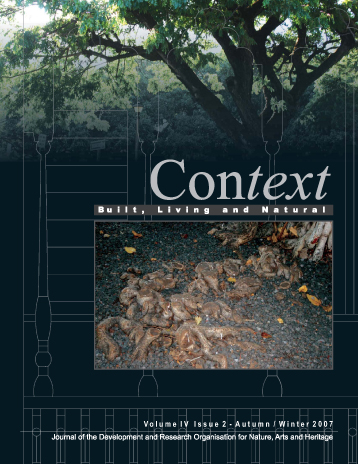Volume IV Issue 2
Editorial
Simple, natural and colloquial forms are probably the ones that can withstand the test of times and are effectively sustainable. This issue discusses few such vernacular methodologies. Anshu Meshack illustrates this through the inherent local approach in dealing with the post tsunami conditions in Andaman and Nicobar. Likewise, the analysis of the traditional Himalayan house by O. C. Handa and, Ranbir Singh’s observations of the localised attempts in conserving the Haryana Chaupal emphasise the need to understand the regional approach as a long-term solution.
Pencil and paper used creatively can do wonders, such is the effort by Cheenu Bhogal who has captured Shimla’s rich heritage in his etchings. We also introduce a new theme on ‘interpretation’ from this issue onwards with Ranit Maiti’s article on interpreting Indraprastha architecture. While participatory projects such as the successful water supply programme in Indore set models for community initiatives, Yatin Pandya’s Manav Sadhna building design proves the adage, ‘there is no such thing as waste but a misplaced resource’.
Two years have passed since the launch of the ambitious JNNURM programme for improving the face of 63 Indian cities. Multifarious urban issues have surfaced in the wake of progressing City Development Plans (CDP) and Detailed Project Reports (DPR). All 63 cities have rightfully performed the ritual of submitting the CDP’s and more than 600 DPR’s for various projects have been submitted with 250 plus approved and funds disbursed. Whether the cities are actually trying to achieve the well-stated vision in their CDP’s or just utilising these funds to complete a backlog of infrastructural projects is debatable
It seems the mission is plagued with its own malady though the recent emphasis on urban reforms by the Ministry of Urban Development could guide the mission in the right direction. Veena Ish’s review on the required reforms, Kiran Kalamdani’s perspective about Pune and Tarachu Fithu’s statement about difficulties in implementation of strategies in Nagaland bring forth few insights about this ongoing NURM programme.
Shikha Jain
Contents
Editorial
Compiling Records and Interpretation
Built Heritage of Bawal — A Documentation
Vanicka Arora
Shimla Etchings
Cheenu Bhogal
Indraprastha Architecture: An Attempt at Interpretation
Ranit Maiti
Methods and Approaches
A Heritage of Cultural Resilience
Anshu Meshack
Houses of the Gaddis of Himachal : Building Technologies of Remote Himalayan Region
O. C. Handa
The Artistic Heritage : Can we save the Chaupal?
Ranbir Singh
Sustainable Solutions
Unique Initiatives with Community Participation: Pro-poor, Demand-responsive
Pradip Kumar Nandi
Recycling Domestic Waste as Building Components: An Environmental, Economic and Aesthetic Imperative
Yatin Pandya
Urban Governance - INN URM Reforms: a Critical Look
Veena Ish & Sumita Dawra
Pune Urban Area and the Progress of CDP under JNNURM
Kiran Kalamdani
Implementation of JNNURM in Kohima, Nagaland
Tarachu Fithu
Events and Conferences
Heritage Album
The Bengal Banyan in Hawaii
Dronah Archives
Maluty Temples
Bullu Imam

